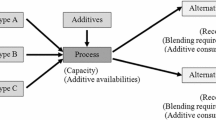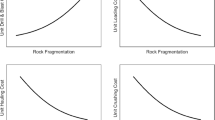Abstract
This paper presents an algorithm for optimizing the scheduling of trackless equipment in underground mines. With the shortest working interval and maximum productivity as goals, a genetic algorithm (GA) is used to solve the problem, and obtain the optimal working sequence with the most suitable equipment configuration possible. The input for the proposed method is the number of units and capacity of trackless equipment, the production process, ore amount in stopes, and the distance between stopes. The algorithm is verified using four setups of 5 stopes with 5 cycles, 5 stopes with 15 cycles, 10 stopes with 10 cycles, and 10 stopes with 30 cycles. The solution time of the algorithm is no more than 20 min, which is acceptable for practical applications. The results show that the setup of 10 stopes with 30 cycles is closer to the actual production of the mines, and the optimization model can effectively improve the operation efficiency. In this scenario, the robustness of the optimization is tested by simulating equipment failure events. Under the condition of 8% failure rate, the operation time is extended over 3.21–14.56% than expected, which represents strong robustness. The algorithm can quickly provide a feasible and effective solution for the production scheduling decision of trackless equipment in underground mines.















Similar content being viewed by others
References
Aras C, Dagdelen K, Johnson T (2019) Mining goes digital: proceedings of the 39th international symposium ‘Application of computers and operations research in the mineral industry’. CRC Press, Wroclaw
Pinedo M (2012) Scheduling, vol 5. Springer, New York
Gustafson A, Schunnesson H, Kumar U (2015) Reliability analysis and comparison between automatic and manual load haul dump machines. Qual Reliab Eng Int 31(3):523–531
Gershon, ME (1983). Mine scheduling optimization with mixed integer programming. United States
Vagenas N (1991) Dispatch control of a fleet of remote-controlled/automatic load-haul-dump vehicles in underground mines. Int J Prod Res 29(11):2347–2363
Bernardo JJ, Gillenwater E (1991) Sequencing rules for productivity improvements in underground coal mining. Decis Sci 22(3):620–634
Nehring M, Topal E (2007) Production schedule optimisation in underground hard rock mining using mixed integer programming. Project Evaluation Conference, June, pp 1–8
Nehring M, Topal E, Knights P (2010) Dynamic short term production scheduling and machine allocation in underground mining using mathematical programming. Min Technol 119(4):212–220
Nehring M, Topal E, Kizil M, Knights P (2012) Integrated short-and medium-term underground mine production scheduling. J South Afr Inst Min Metall 112(5):365–378
Topal E, Kuchta M, Newman A (2003) Extensions to an efficient optimization model for long-term production planning at LKAB’s Kiruna Mine. In: Applications of Computers and Operations Research in Minerals Industries
Newman A, Kuchta M, Martinez M (2007) Long-and short-term production scheduling at LKAB’s Kiruna Mine. In: Handbook of operations research in natural resources. Springer, Boston, pp 579–593
Martinez MA, Newman AM (2011) A solution approach for optimizing long-and short-term production scheduling at LKAB’s Kiruna Mine. Eur J Oper Res 211(1):184–197
O’Sullivan D, Newman A (2014) Extraction and backfill scheduling in a complex underground mine. Interfaces 44(2):204–221
O’Sullivan D, Newman A (2015) Optimization-based heuristics for underground mine scheduling. Eur J Oper Res 241(1):248–259
Smith M, Dimitrakopoulos R (1999) The influence of deposit uncertainty on mine production scheduling. Int J Surf Min Reclam Environ 13(4):173–178
Carpentier S, Gamache M, Dimitrakopoulos R (2016) Underground long-term mine production scheduling with integrated geological risk management. Min Technol 125(2):93–102
Song Z, Schunnesson H, Rinne M, Sturgul J (2015) Intelligent scheduling for underground mobile mining equipment. PLoS One 10(6):e0131003
Schulze M, Rieck J, Seifi C, Zimmermann J (2016) Machine scheduling in underground mining: an application in the potash industry. OR Spectr 38(2):365–403
Åstrand M, Johansson M, Zanarini A (2018) Fleet scheduling in underground mines using constraint programming. In: International conference on the integration of constraint programming, artificial intelligence, and operations research. Springer, Cham, pp 605–613
Darling P (2011) SME mining engineering handbook, 3rd edn. Society for Mining, Metallurgy, and Exploration, Englewood
Acknowledgment
We would like to thank Yuhang Liu with the help of literature collection.
Funding
This work has been funded by the National Key R&D Program of China (2018YFC0604400), Fundamental Research Funds for the Central Universities (No. FRF-TP-20-001A1), Natural Science Foundation of China (71573012), and China Scholarship Council.
Author information
Authors and Affiliations
Corresponding author
Ethics declarations
Conflict of Interest
The authors declare that they have no conflict of interest.
Additional information
Publisher’s Note
Springer Nature remains neutral with regard to jurisdictional claims in published maps and institutional affiliations.
Rights and permissions
About this article
Cite this article
Wang, H., Tenorio, V., Li, G. et al. Optimization of Trackless Equipment Scheduling in Underground Mines Using Genetic Algorithms. Mining, Metallurgy & Exploration 37, 1531–1544 (2020). https://doi.org/10.1007/s42461-020-00285-8
Received:
Accepted:
Published:
Issue Date:
DOI: https://doi.org/10.1007/s42461-020-00285-8




